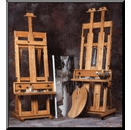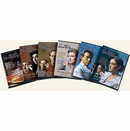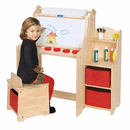Uses, Tips and Techniques for Light Boxes

Loading zoom
A light box, or light table, is an illuminated flat workspace used to trace images or patterns from one source to another. Artists will often sketch their original subject onto a piece of paper, outline it in a darker ink source and then lightly transfer it on to their choice of art paper (i.e, watercolor paper). Many artists find they are a tremendous time-saver and a satisfyingly efficient way to create.
Lightboxes are an especially ideal tool for animators and illustrators. They allow for accurate repeats in pattern or subject matter. For example, an illustrator may create a “master” copy of a room in a house, and then use that backdrop for many different scenes by simply changing around the people in their various activities. Animators may use a lightbox to trace an underlying, original image and then slightly alter its form or position to create different cells of images. These individual cells can then be captured by a camera to create the illusion of animation and movement.
Other uses for lightboxes are: embroidery, appliqués, quilting, needlework, scrapbooking, embossing, tattoos, cut-outs, filigrees and pierced work.
Things to consider when selecting your lightbox:
• Price Point—you will find that a wide variety of lightboxes are available from as little as $30 to thousands of dollars for a high quality piece of art furniture. One popular budget-friendly model is the Artograph Light Tracer II found here: Light Tracer II.
• Workspace—this is two-fold: you need to consider where you will use your lightbox the most (and remember, many lightboxes are portable), and you need to consider what is the dimension you prefer for a drawing surface. Do you tend create rather large pieces of art, or work on more than one drawing at the same time?
• Lightsource—all bulbs will get hot and all bulbs will burn out. The best bulbs to use are energy saving lightbulbs. They will save you money and are less likely to cause burns on your table or work surface.
• Top Surface Material—there was a time when lightboxes were only made with glass tops. Glass tops are prone to cracking from the heat of the bulb. I mention this because they are still available, but the better top surface sheet will be acrylic. Acrylic light table surfaces are slightly flexible and shatterproof.
• Utility Space—this is a matter of preference. Many artists like to have a place to store or hold pencils and pens. This could be in the form of a few well-places holes or a tray at the top of the lightbox.
Once you start using a lightbox, you will wonder how you ever got along without one.
Copyright © 2002-2025 Madison Art Shop™ LLC. All Rights Reserved.




















